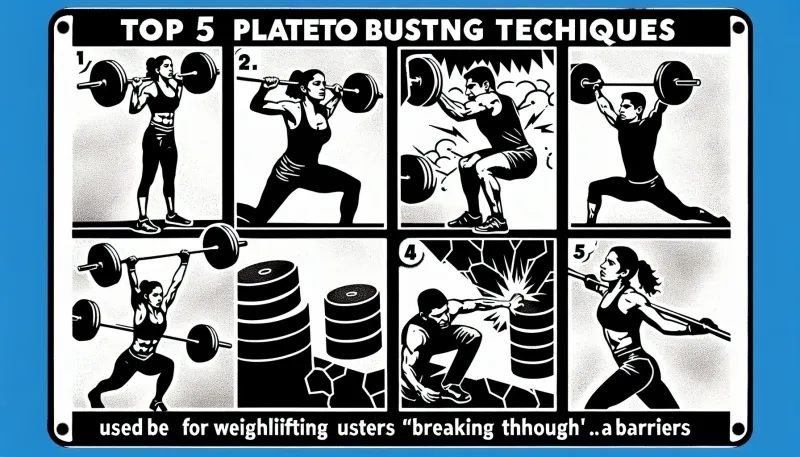Top 5 Plateau Busting Techniques for Weightlifters to Break Through Barriers

Discover the top 5 plateau-busting techniques for weightlifters to break through barriers and continue making gains in strength and muscle mass.
In the journey of weightlifting, hitting a plateau is a common yet frustrating experience. Whether you're a novice lifter or a seasoned athlete, encountering a standstill in progress can dampen motivation and hinder gains. This article presents the top 5 plateau-busting techniques for weightlifters to break through barriers and resume their upward trajectory.
1. Modify Your Routine
Sticking to the same workout routine for an extended period can lead to adaptation, where the body no longer responds to exercises as effectively. To counter this, it's crucial to introduce variation. Consider employing one or more of the following strategies:
Alter Exercise Selection
Swap out some of your standard exercises for new ones that target the same muscle groups. For example, if you've been doing back squats consistently, try incorporating front squats or Bulgarian split squats.
Change Exercise Order
Sometimes, simply reordering the exercises in your routine can shock your muscles into new growth. If you typically start with heavy compound lifts, try beginning your session with isolation exercises.
Adjust Rep and Set Schemes
Changing the number of reps and sets can also stimulate progress. For instance, if you've been working in the 8-12 rep range, consider doing lower rep, higher weight sets, or higher rep, lower weight sets for a few weeks.
2. Focus on Progressive Overload
Progressive overload remains one of the most effective principles for continued gains. Ensure you're gradually increasing the weight, reps, or volume over time. Here are a couple of key ways to implement it:
Incremental Weight Increases
Aim to increase the weight you lift by a small percentage every one to two weeks. Even a 2.5% increase can contribute significantly over time.
Volume Increases
Beyond lifting heavier, increasing overall workout volume (reps x sets x weight) can effectively push through plateaus. Adding an extra set or a few more reps per exercise can make a difference.
3. Prioritize Recovery
Recovery is a pivotal aspect often underestimated by weightlifters. Insufficient recovery can lead to stagnation and plateaus. Focus on the following recovery-related strategies:
Ensure Adequate Sleep
Quality sleep is essential for muscle repair and hormonal balance. Aim for 7-9 hours of sleep per night to optimize performance and recovery.
Incorporate Active Recovery
Engage in low-intensity activities such as yoga, stretching, or light swimming to promote blood flow and aid in recovery without adding extra strain.
Nutrition and Hydration
Maintain a well-balanced diet rich in protein, carbohydrates, and healthy fats. Staying hydrated also supports muscle function and recovery. Consider supplements like BCAAs or protein powders if needed.
4. Implement Periodization
Periodization involves cycling different phases of training to avoid overtraining and stimulate continuous progress. It can be divided into macro, meso, and microcycles:
Macrocycle
The macrocycle is the longest phase, typically lasting several months to a year. It outlines the overall training objectives, such as building strength, hypertrophy, or endurance.
Mesocycle
Mesocycles are intermediate phases usually lasting 4-6 weeks, focusing on specific training goals that align with the macrocycle. For example, a mesocycle can concentrate on hypertrophy before transitioning to strength.
Microcycle
Microcycles are the shortest phases, lasting about a week. They detail the specific workout plan and recovery days within a week, ensuring a structured and balanced approach to training.
5. Monitor and Adjust
Continuously tracking your progress and making necessary adjustments is vital for breaking through plateaus. Here's how to stay on top of your game:
Keep a Training Journal
Document your workouts, including exercises, sets, reps, and weights used. Tracking progress helps identify patterns and make informed adjustments when needed.
Regular Assessments
Assess strength and conditioning regularly through testing one-rep maxes, performance in specific lifts, or body composition analyses to gauge progress.
Seek Professional Guidance
Consulting with a coach or personal trainer can provide new perspectives and customized strategies to overcome plateaus effectively. A professional can also ensure your form and techniques are optimal.
Conclusion
Plateaus are a natural part of any weightlifter's journey, but they are not insurmountable. By incorporating these top 5 plateau-busting techniques—modifying your routine, focusing on progressive overload, prioritizing recovery, implementing periodization, and monitoring and adjusting your training—you can break through barriers and continue making significant gains. Stay adaptable, remain patient, and trust the process as you push towards your fitness goals.



























